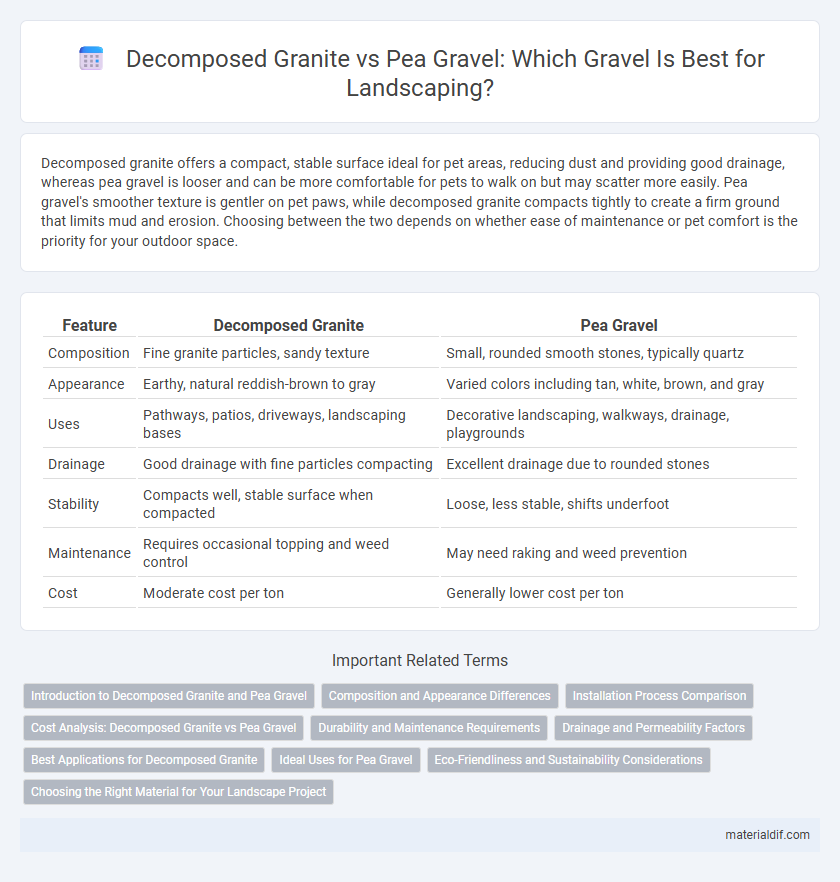Decomposed granite offers a compact, stable surface ideal for pet areas, reducing dust and providing good drainage, whereas pea gravel is looser and can be more comfortable for pets to walk on but may scatter more easily. Pea gravel's smoother texture is gentler on pet paws, while decomposed granite compacts tightly to create a firm ground that limits mud and erosion. Choosing between the two depends on whether ease of maintenance or pet comfort is the priority for your outdoor space.
Table of Comparison
| Feature | Decomposed Granite | Pea Gravel |
|---|---|---|
| Composition | Fine granite particles, sandy texture | Small, rounded smooth stones, typically quartz |
| Appearance | Earthy, natural reddish-brown to gray | Varied colors including tan, white, brown, and gray |
| Uses | Pathways, patios, driveways, landscaping bases | Decorative landscaping, walkways, drainage, playgrounds |
| Drainage | Good drainage with fine particles compacting | Excellent drainage due to rounded stones |
| Stability | Compacts well, stable surface when compacted | Loose, less stable, shifts underfoot |
| Maintenance | Requires occasional topping and weed control | May need raking and weed prevention |
| Cost | Moderate cost per ton | Generally lower cost per ton |
Introduction to Decomposed Granite and Pea Gravel
Decomposed granite is a weathered granite material that breaks down into smaller particles, offering a compact, natural-looking surface ideal for walkways and patios. Pea gravel consists of small, smooth, rounded stones measuring approximately 1/4 to 3/8 inch in diameter, commonly used for landscaping, driveways, and drainage solutions. Both materials provide different textures and drainage properties, making them suitable for distinct outdoor applications.
Composition and Appearance Differences
Decomposed granite consists of weathered granite rock fragments that are finely crushed, creating a compact, sandy texture ideal for pathways and patios, while pea gravel is composed of smooth, rounded stones averaging 1/4 to 3/8 inches in diameter, offering a polished and decorative appearance. The color palette of decomposed granite ranges from tan and brown hues to reddish tones, contrasting with pea gravel's diverse mix of natural colors including white, gray, brown, and red. These composition and appearance differences affect drainage, stability, and aesthetic appeal in landscaping or construction projects.
Installation Process Comparison
Decomposed granite installation involves compacting layers with a roller to create a stable, solid surface ideal for pathways and patios, requiring proper base preparation and moisture control. Pea gravel installation is simpler, typically consisting of laying a landscape fabric base followed by spreading and raking the small, rounded stones, offering easier adjustments and drainage. Both materials demand edge restraints to prevent spreading, but decomposed granite requires more effort to achieve long-term stability compared to the quicker, low-maintenance process of pea gravel.
Cost Analysis: Decomposed Granite vs Pea Gravel
Decomposed granite generally costs between $3 to $5 per square foot, making it a budget-friendly option for pathways and landscaping projects, while pea gravel ranges from $2 to $6 per square foot depending on the type and quality. Installation costs for decomposed granite can be slightly higher due to the need for proper base preparation and compaction, whereas pea gravel requires less groundwork but may need more frequent replenishment. Overall, decomposed granite offers long-term value with lower maintenance, while pea gravel may incur higher recurring costs despite a potentially lower initial price.
Durability and Maintenance Requirements
Decomposed granite offers superior durability compared to pea gravel due to its compactable nature, creating a stable surface resistant to shifting and erosion. Maintenance for decomposed granite involves occasional replenishing and periodic re-leveling to preserve its firmness, while pea gravel requires frequent raking and can migrate easily, demanding more active upkeep. Both materials are permeable, but decomposed granite's cohesive structure reduces weed growth, minimizing long-term maintenance efforts.
Drainage and Permeability Factors
Decomposed granite features fine particles that compact tightly, resulting in moderate drainage and permeability ideal for pathways and patios where slight water retention is beneficial. Pea gravel's rounded, larger stones create ample gaps that promote superior drainage and permeability, making it optimal for areas requiring efficient water runoff. Selecting between decomposed granite and pea gravel depends on specific drainage needs and soil stability for landscaping projects.
Best Applications for Decomposed Granite
Decomposed granite (DG) excels in landscaping applications that require natural aesthetics and excellent compaction, making it ideal for pathways, patios, and driveways. Its fine, sandy texture binds well, creating a stable surface that resists erosion while allowing for good drainage in garden beds and xeriscaping. Compared to pea gravel, DG provides a smoother, more uniform finish that minimizes movement and improves accessibility in high-traffic outdoor areas.
Ideal Uses for Pea Gravel
Pea gravel is ideal for pathways, driveways, and landscaping projects where smooth, rounded stones enhance comfort and drainage. Its small, uniform size makes it perfect for play areas and garden beds, providing excellent weed control and erosion prevention. Unlike decomposed granite, pea gravel offers superior cushioning and slip resistance, making it safer for children and pets.
Eco-Friendliness and Sustainability Considerations
Decomposed granite is eco-friendly due to its natural origin as weathered granite that requires minimal processing, promoting sustainable landscaping by reducing carbon footprint. Pea gravel, sourced from naturally rounded river stones, is also sustainable but may involve more energy-intensive extraction and transportation processes. Both materials are permeable, aiding in groundwater recharge and reducing runoff, making them environmentally beneficial options for sustainable ground cover.
Choosing the Right Material for Your Landscape Project
Decomposed granite offers a compact, stable surface ideal for pathways and patios, while pea gravel provides excellent drainage and a decorative appearance for garden beds and borders. Evaluating factors like soil stability, drainage needs, and aesthetic preferences helps determine which material best suits your landscape project. For areas requiring durability and low maintenance, decomposed granite is preferable, whereas pea gravel excels in creating visually appealing, well-drained spaces.
Decomposed Granite vs Pea Gravel Infographic

 materialdif.com
materialdif.com